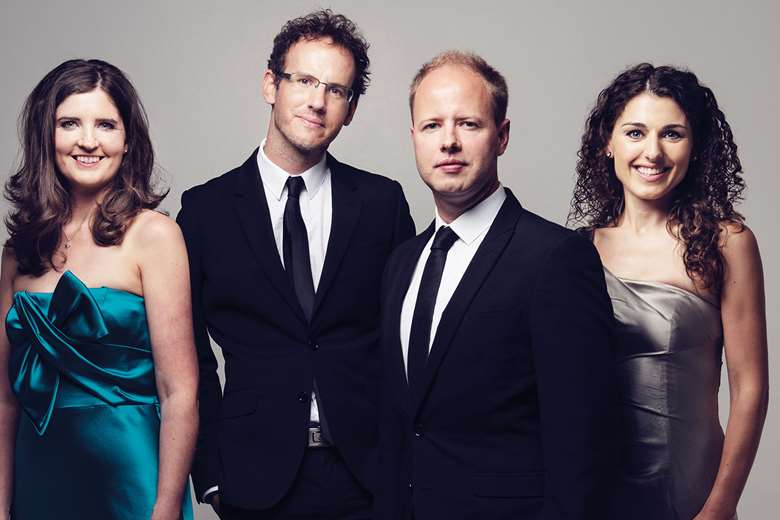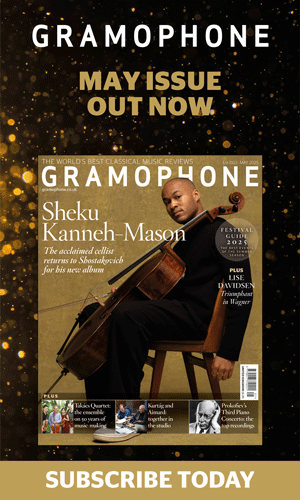In search of a perfect string quartet sound, with the Carducci Quartet
James Jolly
Friday, January 3, 2025
How do a string quartet pursue their dream of the ideal ensemble sound? James Jolly caught up with the Carducci Quartet to learn about how they went about it

I’ve never given a lot of thought as to how a string quartet goes about pursuing its particular sound, over and above sheer hard work. I’d assumed – invariably quite rightly – that the four players came together, bringing whatever instruments they had, and maybe in time they’d ‘upgrade’ one or two. Of course, some quartets have a set of new instruments made for them, specifically ‘matched’ to blend (Robert Brewer Young, who featured in October’s Carte blanche, made the four for the Australian Quartet). The Carducci Quartet, formed in 1997 have, over the past decade or so, been replacing their instruments in pursuit of their ideal sound. It’s a journey that piqued my interest, and so I tracked them down recently to find out more.
We met up at the Gloucestershire home of Andrew Neubauer and Penny Wright, a couple whose evident love and deep knowledge of music fires their quiet philanthropy. They have converted an ancient barn into a 100-seater hall where they host private concerts. It’s also used as a recording venue (Charles Owen’s recent Schumann album was made there). The Quartet were in The Cotswolds to play an afternoon concert and we grabbed time beforehand to talk about their instruments. Sitting around the kitchen table with me were Matthew Denton (first violin), Michelle Fleming (second violin), Eoin Schmidt-Martin (viola) and Andrew Neubauer; Penny Wright and Emma Denton (cello) were preparing for the concert.
Matthew Denton was pragmatic about the decision. ‘As you guessed, we started with our own instruments. I had a new English violin, Eoin had a new American viola, Michelle had an old German violin, and Emma had an old English cello. So we had a rather motley set-up. At the time, we didn’t think much of it, but we found we spent a lot of our time trying to blend, trying to play in tune with each other. You could say, yes, but that’s what a new string quartet does, but it felt like we had to spend a lot of time, and then some, doing that. Somehow we started getting the sense that perhaps we should try and upgrade our instruments and try different ones. And when we did, we started to notice, one at a time, that actually this was making a big difference. Suddenly certain things would become so much easier. A bit of tuning that was always a problem suddenly was completely fixed.’
Eoin Schmidt-Martin adds ‘it was incredibly lucky that my viola – that I’m still playing now – was offered to me to have on loan and that was, I think, one of the first real “lightbulb moments” within the quartet. That was about 18 years ago. Although the viola that I’d been playing was really a nice instrument, the moment I started with the new one – we were playing the opening bars of the Haydn Frog Quartet – I remember seeing everyone in my peripheral vision reacting and suddenly there was a feeling that the sound was gluing together better. Suddenly we were like, “Oh, wow, this can transform the sound of a quartet”. And I think it had the most profound effect at that early stage. And now by the viola still being there, everything around it somehow has made it sound better.’
When Eoin was first lent his current viola, nobody knew what it was, but after much trying, the owners had it examined by Charles Beare, who declared it to be a Lorenzo Storioni and give it the official stamp. Not only was it a fine instrument, but it was suddenly also a significantly more valuable one! ‘Charles Beare’s imprimatur is worth a lot!’ Andrew adds.
It was in 2015 that the project to upgrade got seriously underway. AN: ‘We were sitting outside and Matt was saying, “Basically, we’re probably not going to get much better without better instruments”. Ironically, they had better instruments when they were all in college because they were being lent them, and now they didn’t have that access. And, as you know, expensive instruments tend to be bought as trophy assets that are lent to soloists. So nobody’s really buying or helping quartets to buy instruments. And so I cogitated upon that for a while, and then I suggested there might be a way that it could be solved.’ MD: ‘At about that same time, we were also planning a Beethoven cycle. One of the programmes we did was with Beethoven’s letters interspersing quartets, and in the Heiligenstadt Testament Beethoven mentions that he’s got this set of instruments, and he writes to his brothers that “I’m going to leave them to you. Look after them. Don’t fight over them because they’re very valuable. Decide what you’re going to do with them.” So we were like, “Oh, what instruments did Beethoven have?” We commissioned a bit of research and they turned out to be a Rugeri, there were two Amatis, and a Guarneri cello. And so we thought, well, that sounds like a nice kind of set of instruments. So we thought we’d look at instruments from that era.’
The presence of Amati instruments is interesting. Andrew Neubauer explains: ‘Given the choice, soloists prefer instruments that emphasise brighter higher harmonics rather than the lower overtones produced by Amatis. As a result the best Strads and Del Gesùs fetch significantly higher prices than most instruments that are well suited to ensemble playing, such as Amatis. These “quartet” instruments, however, are not cheap, and are generally too expensive for players to acquire. There’s a limited number of investors in the market for fine fiddles and they tend to purchase instruments that are suitable for soloists because these are more easily resold and have a higher profile. As a result the market for high-quality ensemble instruments is currently fairly limited, since they justifiably sell for high prices but there are only a few investors buying these instruments.’
With the Storioni viola in place, Emma Denton’s cello was the first to be ‘upgraded’, and after trying one that she loved when she played it alone but then rejected it because its sound was simply too big in the context of the quartet, she settled on a Rugeri. Next came the violins and both have remarkable provenances. Matthew Denton plays an Amati that used to belong to Emanuel Hurwitz, co-leader of the English Chamber Orchestra, a principal violinist of the Melos Ensemble, leader of the New Philharmonia and first violinist of the Aeolian Quartet. MD: ‘He lived, like the Amadeus Quartet, up in Hampstead when they were nearly all buying up and using Strads, so Manny had plenty of options, but it was this Amati that he loved.’ AN: ‘He said it was transformational for him, and that when he found this particular instrument, he just knew it was the one.’ MD: ‘And it’s still changing. I’m loving it more and more – we’ve just been rehearsing the Debussy Quartet for this afternoon. I don’t think I’ve played it before on the Amati – we haven’t played it for about three years, but suddenly now it’s a completely different piece.’
Michelle Fleming’s violin – also a Storioni – has arguably the most extraordinary provenance of any instrument currently being used by a string quartet, and her first encounter with it has a strangely fateful twist. Eoin Schmidt-Martin tells the story: ‘It was 1998, and Michelle and I were on a US tour with the Irish Youth Orchestra. We went to the Tanglewood Festival, and we heard the Guarneri Quartet there. I remember it vividly. They played the Beethoven Op 18 No 4, and I remember being absolutely blown away.’ The twist of fate – and Eoin still confesses to goosebumps when he thinks about it – is that the instrument they heard played by Arnold Steinhardt, the Guarneri’s founder and first violin for its 45-year history, is the one that would one day be played by Michelle. ‘I got my violin in December of 2022, and it didn’t take too long to make the decision about that,’ she says. ‘I felt the connection was almost instant. (I’d long admired the Guarneri Quartet’s recordings.) I think it just gives you freedom. It releases you from worrying about the sound that’s going to come out of your violin. With the instruments that we’ve had in the past, there have been always moments that I just felt like this doesn’t work on this violin. So I had to somehow try to jump that hurdle to make it sound acceptable. Whereas with the Storioni it just works.’
Interestingly, that Storioni instrument – not just for the Guarneri’s entire history, but before that in the hands of both leaders of the Budapest Quartet, Emil Hauser and Josef Roisman – had played the first violin part and now it plays second. ‘It actually started life as a viola. It was a very small viola,’ Michelle points out. ‘It has quite a dark tone to it, so actually it’s more ideal as a second violin.’
The proof of the pudding, as they say, is in the eating. Eoin Schmidt-Martin offers that proof: ‘When you play to people who have known you your whole career and without them knowing the background they come up to you and say, “Oh my gosh, you are sounding so much better. What’s happening, what’s going on?” And then you reveal the story and actually they become even more excited when they find out about the instruments. Audiences are just so interested in hearing the history and where our instruments have come from.’ And maybe the instruments, too, enjoy their new lives … MD: ‘I’ve had a curious experience – it may be partly in my mind. With Manny’s violin and the repertoire that he played a lot – I mean, he did the complete Haydn quartets with the Aeolians – it feels great, really comfortable. But the other pieces that he did with the Melos Ensemble were pieces that I used to find really, really difficult, like the Schubert Octet first violin part and the Beethoven Septet. Those quite virtuosic parts used to scare me. And somehow on his violin, it’s just so comfortable, as if the violin feels “I’ve been here”. It does raise a question: if the violin has played those pieces hundreds of times already, is there something retained in it?
Penny Wright, who with Andrew Neubauer, has hosted 25 Carducci Quartet concerts in ten years (amounting to 81 string quartets!), emails me later with her thoughts about the role the new instruments have played in the Quartet’s journey. ‘These are musicians that we now know very well and my own observation about this whole process is that acquiring these amazing new instruments has had a profound effect on the quartet – obviously the sound quality, but also psychologically. The instruments sound better and it seems that they are also easier to play in some way, especially to get the intonation and blending right, and that has increased everybody’s confidence and enjoyment which in turn leads to better quartet-playing.’
For more information about the Carducci Quartet, including concert dates, visit carducciquartet.com








